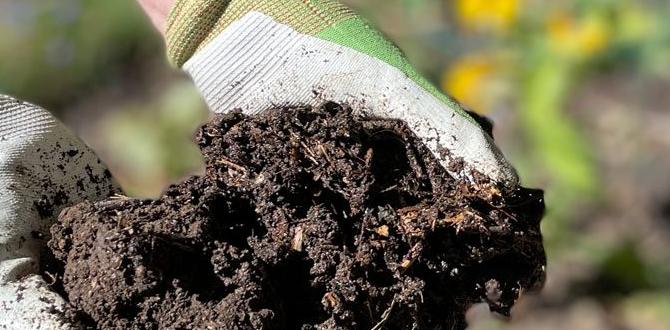Don’t let your amaryllis bulb become a sad, forgotten lump! This guide will show you exactly how to care for your amaryllis plant indoors, from planting to reblooming, ensuring you enjoy vibrant blooms year after year with simple, effective tips for beginners.
Amaryllis bulbs are like nature’s own little surprises, promising spectacular, trumpet-shaped flowers that can brighten any home. But sometimes, after the initial dazzling show, these bulbs can seem a bit mysterious. Many new gardeners wonder what to do with them once the flowers fade, fearing they’ve missed their chance for future blooms. It’s a common question, and rest assured, with a little know-how, your amaryllis can be a returning star in your indoor garden. This guide will walk you through every step, making amaryllis care simple and rewarding, from planting your bulb to encouraging it to bloom again.
We’ll cover everything you need to know, so get ready to discover the secrets to a happy, blooming amaryllis all year round. Let’s get started on unlocking the full potential of this stunning plant!
Discovering the Magic of Amaryllis Indoors
Amaryllis plants, scientifically known as Hippeastrum, are celebrated for their large, dramatic flowers that often appear in shades of red, pink, white, and even striped patterns. They are particularly popular during the holiday season, bringing a festive and elegant touch to homes and gatherings. The bulbs themselves are quite substantial, hinting at the magnificent blooms they hold within. For indoor gardeners, especially those new to the scene, amaryllis offers a fantastic opportunity to witness impressive growth and flowering with relatively straightforward care.
The appeal of amaryllis lies in its ability to bloom indoors, often with minimal fuss once you understand its needs. Unlike some plants that require specific outdoor conditions or complex feeding schedules, amaryllis bulbs can be coaxed into flowering in a pot on your windowsill. This makes them ideal for apartment dwellers, families, and anyone looking to add a splash of vibrant life to their living space without needing a large garden. The process of watching a flower stalk emerge from what looks like a simple bulb, unfurl its leaves, and then burst into magnificent colour is truly magical. It’s a rewarding experience that even the most inexperienced gardener can achieve.
This guide is designed to demystify amaryllis care, ensuring you can enjoy these spectacular blooms not just once, but year after year. We’ll break down the process into easy-to-follow steps, covering everything from selecting a healthy bulb to its post-flowering rejuvenation. So, get ready to become an amaryllis expert!
Getting Started: Planting Your Amaryllis Bulb
The journey to beautiful amaryllis blooms begins with planting the bulb. This is a critical step that sets the stage for future success. Don’t worry, it’s remarkably simple and doesn’t require fancy equipment. The key is to provide a good balance of drainage and support.
Choosing the Right Pot
Select a pot that is about 6-8 inches (15-20 cm) in diameter. Amaryllis bulbs prefer a snug fit, so a pot that’s only slightly larger than the bulb is ideal. Too much space can lead to the bulb spending energy on root growth rather than flower production. Ensure the pot has drainage holes at the bottom; this is non-negotiable to prevent waterlogged soil and root rot.
Material-wise, both terracotta and plastic pots work well. Terracotta pots are porous, which allows for better air circulation and helps prevent overwatering, but they can dry out faster. Plastic pots retain moisture better and are lighter. Whatever material you choose, drainage is paramount.
Selecting the Best Potting Mix
A well-draining potting mix is essential. A standard, good-quality potting soil is usually sufficient. You can also create your own by mixing equal parts peat moss, perlite, and coarse sand. This blend ensures good aeration and prevents the soil from becoming compacted, which is vital for healthy root development.
Many gardeners also opt for a specialized bulb potting mix. You can find these at your local garden center. If you’re feeling eco-conscious, consider using compost-based potting soil, but ensure it’s aerated with perlite or sand to maintain drainage. A good starting point is to look for potting mixes that mention good drainage properties or are suitable for cacti and succulents, as these tend to have the necessary aeration.
The Planting Process: Step-by-Step
Planting your amaryllis bulb is straightforward. Follow these simple steps:
- Add Potting Mix: Fill your chosen pot with about one-third of the potting mix.
- Position the Bulb: Place the amaryllis bulb on top of the soil. If it has a slightly pointy end and a flatter bottom, the pointy end should face upwards.
- Add More Soil: Fill the pot with more potting mix, leaving the top one-third to one-half of the bulb exposed above the soil line. This is crucial to prevent the bulb from rotting. Roots will grow from the bottom and sides, and the leaves and flower stalk will emerge from the top.
- Water Lightly: Water the soil gently after planting. Don’t drench it; just moisten it enough to settle the soil around the bulb.
- Placement: Place the pot in a location that receives bright, indirect light.
It’s important NOT to bury the entire bulb. The exposed portion helps prevent rot and encourages faster growth. The roots will anchor the bulb, and the plant will draw strength from the buried portion and the soil.
Essential Care for a Blooming Amaryllis
Once your amaryllis is planted, providing the right environment and consistent care will encourage it to sprout and bloom. The needs of an amaryllis are quite specific, but once you understand them, you’ll be able to foster a thriving plant.
Light Requirements
Amaryllis bulbs thrive in bright, indirect light. A south-facing or east-facing window is often ideal. If your light is too weak, the plant may produce long, spindly leaves and weak flower stalks. Conversely, direct, intense sunlight, especially during the hottest part of the day, can scorch the leaves and flower buds.
If you don’t have a bright window, you can supplement with a grow light. A full-spectrum LED grow light placed about 12-18 inches above the plant for 12-14 hours a day can make a significant difference. Rotate the pot regularly, about a quarter turn every few days, to ensure even growth towards the light source. This prevents the plant from leaning dramatically in one direction.
Watering Needs
Watering is arguably the most critical aspect of amaryllis care. The goal is to keep the soil consistently moist but never waterlogged. Allow the top inch of soil to dry out slightly between waterings. When you do water, water thoroughly until you see water draining from the bottom of the pot. Discard any excess water that collects in the saucer.
Overwatering is the quickest way to harm an amaryllis bulb, leading to rot. Underwatering can cause the plant to become stressed, potentially aborting buds or delaying flowering. A good rule of thumb is to check the soil moisture by sticking your finger about an inch deep. If it feels dry, it’s time to water.
Temperature and Humidity
Amaryllis prefers average room temperatures, ideally between 65-75°F (18-24°C) during its active growing phase and blooming period. Avoid placing the plant near drafts from doors, heating vents, or air conditioners, as sudden temperature fluctuations can stress it. Temperatures slightly cooler, around 60-65°F (15-18°C), might actually help in triggering blooming, especially if initiated after a rest period.
Humidity is less of a concern for amaryllis, as they are quite adaptable to typical indoor humidity levels. If your home is exceptionally dry, especially in winter, placing the pot on a pebble tray filled with water can slightly increase humidity around the plant without letting the bulb sit in water.
Fertilizing
Once your amaryllis has established, usually after new growth appears, you can begin a regular feeding schedule to support its energy needs for flowering and subsequent growth. Use a balanced liquid fertilizer diluted to half strength. Apply it every 2-4 weeks while the plant is actively growing (producing leaves and/or flowers).
Avoid fertilizing a dormant bulb or immediately after planting, as it can encourage excessive leafy growth at the expense of flowers. Once the flower stalk has faded and you’re focused on leaf development, feeding becomes more important for building up energy reserves in the bulb for the next blooming cycle. Look for fertilizers with balanced NPK ratios, such as 10-10-10, or those slightly higher in potassium to support overall plant health and flowering.
Some experts recommend specific fertilizers formulated for bulbs, which might contain slightly different micronutrient profiles to encourage flowering. However, a general balanced liquid fertilizer, used as directed, will usually suffice for most home gardeners.
Encouraging Your Amaryllis to Bloom Again: The Dormant Period
The magic of amaryllis doesn’t end with the first bloom. With proper care, you can encourage your amaryllis bulb to rebloom year after year. This involves understanding and facilitating its natural dormant cycle, which is crucial for its long-term health and blooming potential.
Post-Bloom Care: What to Do After the Flowers Fade
Once the amaryllis flowers have faded, resist the urge to cut off the flower stalk immediately. The stalk naturally contains nutrients that will eventually be reabsorbed by the bulb. Allow the stalk and leaves to grow and flourish. Keep watering and feeding the plant as you normally would during its active growing phase.
When the flower stalk begins to yellow and dry on its own, you can cut it back. Similarly, yellowing or dying leaves should be removed. The goal is to keep the remaining green leaves healthy and vibrant, as they are responsible for photosynthesizing and storing energy in the bulb for the next blooming cycle.
Initiating the Dormant Period
To encourage reblooming, your amaryllis bulb needs a rest period, typically lasting 2-3 months. This period mimics its natural cycle in warmer climates where it experiences a dry, cooler season. You can induce dormancy in a few ways:
- Stop Watering: Gradually reduce watering until the soil is dry.
- Reduce Light: Move the plant to a cooler, darker location.
- Temperature: Aim for a temperature range of about 45-55°F (7-13°C). A cool basement, a garage, or a cool, dark closet can work.
- Prune Leaves: If the leaves are still green, you can trim them back to about 2 inches above the bulb once they start to yellow naturally. Do not cut green leaves.
This resting period is essential. During this time, the bulb conserves its energy, preparing for the next growth spurt. Do not fertilize during dormancy.
Reviving Your Amaryllis for New Blooms
After the dormant period of about 6-8 weeks, it’s time to revive your amaryllis. Bring the pot back to a brightly lit location and resume watering. You should see signs of new growth—either a flower stalk or leaves—within a few weeks. Once growth appears, you can resume your regular feeding schedule with a balanced liquid fertilizer diluted to half strength.
If you wish to re-pot your amaryllis, do so after its rest period, before you start watering to encourage new growth. Use fresh potting mix and a pot that is similar in size to the previous one, ensuring that the top one-third of the bulb remains exposed. This re-potting helps refresh the soil and provides necessary nutrients for the upcoming blooming season.
Troubleshooting Common Amaryllis Problems
Even with the best intentions, you might encounter a few issues with your amaryllis. Understanding common problems and their solutions will help you keep your plant healthy and blooming.
Problem: Bulb Rot
Cause: Overwatering, poor drainage, or burying the bulb too deeply.
Solution: Ensure your pot has drainage holes and use well-draining soil. Allow the top inch of soil to dry before watering. If you suspect rot, gently remove the bulb from the pot, trim away any soft, brown, or mushy parts with a clean knife, and repot in fresh, dry soil. Allow the bulb to sit in the dry soil for a week before watering lightly. You can also try dusting the cut areas with cinnamon or sulfur powder, which have antifungal properties.
Problem: No Flowers, Only Leaves
Cause: The bulb may not be mature enough, it might not have had a proper dormant period, or it received insufficient light or nutrients during the previous growing season.
Solution: Ensure the bulb has had its mandatory rest period. Provide adequate bright, indirect light during the growing season and follow a regular fertilizing schedule. If the bulb is very small, it might need another season to build up enough energy to flower. Patience is key!
Problem: Flowers Drooping or Bending
Cause: This is very common! The heavy flower heads can sometimes bend the stalks, especially if the plant is stretching towards light.
Solution: As the flower stalk emerges and grows, rotate the pot regularly to encourage upright growth. Once the flower buds are visible, you can gently stake the stalk using a thin bamboo cane or a specially designed plant support. Some people prefer to let nature take its course, enjoying the graceful bend. You can also prune the flower stalk low to the ground once the blooms have faded, which encourages the bulb to conserve energy for its leaves and bulb development.
Problem: Yellowing Leaves
Cause: This can be due to overwatering, underwatering, natural aging, or shock from environmental changes.
Solution: Check soil moisture. If it’s too wet, reduce watering and ensure good drainage. If it’s too dry, water thoroughly. If the lower leaves naturally yellow and die off as new growth emerges, this is normal. Remove them once they are completely dry. If all leaves are yellowing suddenly, there might be a more significant issue, such as a temperature fluctuation or pest problem.
Problem: Pests
Cause: Amaryllis can occasionally be susceptible to common houseplant pests like mealybugs or spider mites, especially if stressed or kept in dry conditions.
Solution: Inspect your plant regularly. If you spot pests, isolate the plant. For light infestations, wipe the leaves and bulb with a damp cloth. You can also use insecticidal soap or neem oil according to product instructions. A blast of water from a hose (if the plant is outdoors) can also dislodge pests. Ensure good air circulation and avoid over-crowding plants.
Amaryllis Care Cheat Sheet
Here’s a quick reference table to summarize the essential care for your amaryllis:
| Aspect | Details |
|---|---|
| Pot Size | 6-8 inches (15-20 cm) diameter, snug fit |
| Potting Mix | Well-draining, e.g., standard potting mix with perlite/sand |
| Planting Depth | Top 1/3 to 1/2 of bulb exposed |
| Light | Bright, indirect light |
| Watering | Keep soil consistently moist, let top inch dry out between waterings. Avoid waterlogging. |
| Temperature (Active Growth) | 65-75°F (18-24°C) |
| Temperature (Dormancy) | 45-55°F (7-13°C) |
| Fertilizing (Active Growth) | Balanced liquid fertilizer, diluted to half strength, every 2-4 weeks. |
| Dormancy Period | 2-3 months (stop watering, cooler temps, reduced light) |
| Re-potting | Every 2-3 years, after dormancy, before new growth. |
Frequently Asked Questions About Amaryllis Care
Q1: How often should I water my amaryllis?
A1: Water when the top inch of soil feels dry. This might be once a week or less frequently, depending on your home’s humidity and temperature. Always ensure good drainage and never let the pot sit in standing water.
Q2: Can I leave my amaryllis outside year-round?
A2: Amaryllis bulbs are native to tropical regions and are not frost-hardy. In warmer climates (USDA zones 9-11), they can be planted outdoors in well-drained soil after the last frost. In cooler climates, they must






